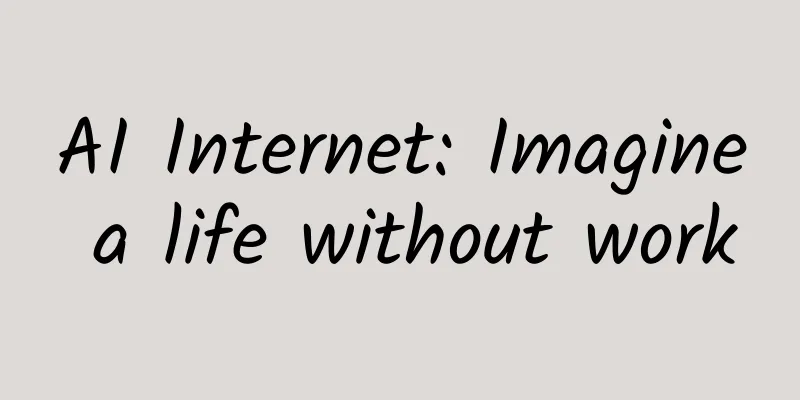AI Internet: Imagine a life without work

|
Recently, I have discussed a lot about the future with Dr. Chen Xiaoliang (founder of Sound Intelligence Technology, an expert in acoustics and speech recognition) because of my entrepreneurial experience. I agree with Dr. Chen’s two key judgments on future trends: 1. After mobile Internet, AI Internet is coming, but it is a slow process. 2. There will be a pullback in the AI field within 2 to 3 years (similar to the Internet in 2000). To describe it in common terms, the future is bright, but the road is tortuous. This article mainly wants to explore what will happen on the tortuous road and what will happen at the end of the road. AI Internet Era Now our daily lives are full of traces of mobile Internet: Toutiao, Weibo, WeChat, Qidian Reading, JD.com, Meituan Takeout, Didi Taxi are always around us. Mobile phones have become an extended organ, and people's lives now revolve around mobile phones. AI Internet will further reconstruct everyone's life model: In the morning, smart assistants like Echo will wake us up from our sleep. When we are still lying in bed, it will combine a group of interesting news according to our preferences. After getting up, the breakfast ordered by the smart assistant has been delivered. Because I am working from home today, I can have a leisurely breakfast. After that, I will put on a pair of AR glasses to start my day's work. When I need to communicate with a colleague, that colleague will be quickly projected to my side, sharing the same perspective to discuss the problem. After working for a while, the smart assistant will remind you that you need to do activities and recommend today's lunch according to your daily habits. You choose one from the recommendations and continue your work for the day. When you need to go out at night, an unmanned car will drive to the designated location to pick you up according to the previous appointment. After returning home at night, the smart assistant reminds you that the housing prices in your hometown have changed again and you can buy it. At this time, you need to wear AR glasses again to experience the condition of the target house in person. Remote work is becoming more and more convenient because of AI Internet, so you may consider saying goodbye to the metropolis with high housing prices and returning to your hometown... In the AI Internet, smart assistants are everywhere, automation is everywhere, and augmented reality is everywhere, which is different from the mobile Internet. Previously, people tried to use IoT (Internet of Everything) to describe the next era, and the picture they imagined was as follows: ---By Gartner However, the expression "Internet of Everything" does not capture the key point of change. Compared with the connection and even the way data is generated, what is more important is obviously the way data is consumed (scenarios and human-computer interaction methods) and processed (such as the cloud). The reason why 2016 is so exciting is that from smart assistants to AR glasses to autonomous driving, each of them has shown a little hope, so people have poured so much enthusiasm into AI. However, the so-called bubble often does not come from the irrationality and lack of imagination of the things themselves, but from the misjudgment of scale. To grasp this scale, we must return to the fundamental technological driving force of the new wave. The core driving force of AI Internet Technological advances in various areas are indeed hinting that AI Internet will come. One of the core cornerstones of the AI Internet is sensors. Obviously, only when the intelligent assistant can fully perceive the changes in the environment in a timely manner can it become truly intelligent. Only when it can truly perceive the environment can it be truly automated. Suppose we say to the intelligent assistant: Please help me play a song. At this time, if there is no data, the only thing the intelligent assistant can do is to randomly select a song. The final result is that you may like Andy Lau, but the song that comes out is Lu Han. This is not a question of intelligence or not. If you ask a stranger to recommend a song to you when you call, the result is the same. At this time, in order to make the intelligent assistant really intelligent, it needs to have eyes, ears and memory. Assuming that it has memory, it will find from your historical data that you are a middle-aged uncle who listens to songs in a nostalgic way, so it will not recommend Lu Han to you. But if it does not have eyes and ears, it may still play a sad song to destroy the atmosphere when you want to play a romantic song. In order to solve this problem, it is necessary to perceive the environment and use the capabilities of eyes (such as cameras) and ears (such as microphone arrays). Through them, the intelligent assistant can recognize whether you are lying alone in bed or with your girlfriend, in a cafe or alone on the street. The positive signal on the sensor technology point is that the accuracy and types of sensors are indeed increasing (see the figure below), and the size is indeed shrinking, but the problem is that the front-end computing power is insufficient, the development of batteries is generally strong, and the data is fragmented. The data of different dimensions of a person is in the hands of different companies. The second cornerstone of the AI Internet is bandwidth and latency. This is the most certain of all variables. Both 5G and WiGig are advancing steadily. People expect 5G to reduce latency by 5 times and increase bandwidth by 10 to 100 times. However, the implementation of 5G involves operators, so it will be relatively slow. It is now predicted that the first 5G network will appear in 2019. WiGig, as a short-range wireless network, is ahead of the curve and was the first to announce the 802.11ad standard, which will increase the transmission rate of WIFI to 1GB. High-speed and low-latency networks pave the way for the development of VR/AR and other technologies. The signal is basically positive in terms of bandwidth and latency. The only obstacle is time. It is obviously unrealistic to expect 5G to be rolled out within three years. The third cornerstone of AI Internet is deep learning, data and computing power. The growth of computing power is the fastest and most certain with the help of GPU. In three years, the training speed has increased by 60 times and the inference speed has increased by about 16 times. The acquisition of data will be subject to the deployment of sensors, but further breakthroughs in algorithms are highly uncertain. Scientists may not be able to handle NLU and unsupervised learning in ten years. This is the biggest risk of delaying the development of AI Internet. Business signals, on the other hand, confirm that many large companies have made the same judgment. The three recent acquisitions related to this are Qualcomm's acquisition of NXP, Samsung's acquisition of Harman, and ADI's acquisition of solid-state laser beam steering technology Vescent Photonics. These acquisitions would not have happened if these companies had not made some kind of prediction about the future. Among them, Qualcomm's acquisition is the most representative. The following figure is a core summary of this acquisition (it should be from WSJ, I can't find the source...): After reading this, you will find that the only reasonable explanation for the largest semiconductor acquisition in history is that AI Internet will come, and this transformation will start with cars. The other two mergers and acquisitions also hold true under this logic. A deep understanding of the development level of this technical factor and a deep understanding of the general public's linear expectations for business performance will help us better understand Dr. Chen Xiaoliang's judgment on future trends. Who is the leader in the AI Internet era? Whoever dominates the AI Internet will be the next BAT. But there is a very critical point here that is covered by inertial thinking, that is, there will be no Windows or Android in the future, but only integrated hardware and software products. Therefore, the future BAT is likely to be born first from hardware product manufacturers. Let's imagine a situation where Oculus Rift, Sony and HTC Vive eventually become extremely popular VR devices and occupy 60% of the market, and the remaining market share is divided up by other small manufacturers. Then which of these three manufacturers would be willing to give up the operating system or the app store, become a Microsoft or Android, and become a pure device manufacturer? No one would do so, which is equivalent to working hard to farm in the spring, but giving the harvest to others for free in the fall. Each company will do everything possible to ensure that it can dominate the ecosystem and get the maximum profit. By extension, there will be no more Microsoft, no more Android, no more Lenovo and Dell, but only Apples of varying sizes. The inertia of history has given many people an illusion that the past model will be repeated, but in fact, the past business reality has profoundly educated all participants. No one wants to become a company that simply makes shells and does sales. Hardware product developers have realized that the core of making products is not sales volume but grasping the brand and ecology. Sales volume without stickiness has only short-term value. This has led to many existing Internet companies' hardware product strategies being very questionable. The core profit model in the Internet era is advertising and games, and the characteristic is that the front end does not make money but the back end realizes it. This has led to Internet companies not being interested in earning front-end profits. Compare the following two strategies: One is to work from high to low. In the early stages of a new category, do not pursue low prices and sales, but instead polish the product and pursue a good reputation. The ideal result is that the brand is the category. One is to start from low to high, and make cheap products in the early stage of a new category, hoping to accumulate quantity and form a valuable entry point. The back-end monetization ideas of Internet companies lead them to choose this method when making hardware, because low prices will result in more quantity, and all market data indeed proves that low prices will result in more quantity. But when it comes to new categories with technological content, going from low to high will actually lead to complete failure. We can see things more clearly by comparing this approach with Rokid (a representative of going from high to low). Cheap smart speakers made from low to high prices may indeed sell more, such as 300,000 units. Rokid, which is made from high to low prices, will obviously sell fewer, such as a few thousand or tens of thousands. But the market has not started at this time, so even if there are more, it is impossible to quickly occupy the market. Cheaper products will be quickly abandoned by users due to product experience limitations (you can't make something that is both cheap and has a good experience in a new category), and people will no longer remember that there is such a product. Although Rokid has not sold many units, Rokid has accumulated its brand value and even represents this category. If smart speakers really take off, it can quickly launch mid-range products to occupy market share. It is still difficult for us to guess who will be the winner in the AI Internet era, but if the two points mentioned above (successful product players will control the ecosystem instead of opening up the operating system, app stores, etc., and Internet companies' idea of using low-priced hardware to grab the entry point is unlikely to change) are true at the same time, then it seems that they should not be the winners of the last era, and the once successful thinking mode is becoming an obstacle to the next step. Imagine a day without work The core of mobile Internet is convenience and cheapness, but another possible consequence of AI Internet is shortened working hours. At the beginning of capitalism, workers had to work 14 to 16 hours a day, and some even worked up to 18 hours. After many struggles, the slogan of an eight-hour workday was finally proposed at the Geneva Conference of the First International in 1866. On May 1, 1886, a large-scale strike and demonstration with about 350,000 participants was held in the United States, centered in Chicago, with demonstrators demanding improved working conditions and an eight-hour workday. This is how the May Day we are familiar with came about. Over the past 100 years, working hours have indeed been shortened, including statutory holidays and weekends. Now everyone spends about 1/3 of the year on vacation (except for entrepreneurs, such as us...). So what further impact will AI have on working hours? A core impact is expected to be that working hours will be further shortened, with the standard working week likely to become five days on and two days off, because many jobs will become worthless, and between shortened working hours and mass unemployment, wise politicians are more likely to choose the former. summary In summary, both technical signals and business signals are reminding us that AI Internet is coming. Different companies and different people will make similar interpretations from different perspectives. For example, in Wuzhen, Lenovo's Yang Yuanqing described it as Smart Internet, and nVidia also made similar statements. But what's interesting is that this kind of thing cannot be proved by any means. There are only signals, and the final judgment depends only on belief or disbelief. As a winner of Toutiao's Qingyun Plan and Baijiahao's Bai+ Plan, the 2019 Baidu Digital Author of the Year, the Baijiahao's Most Popular Author in the Technology Field, the 2019 Sogou Technology and Culture Author, and the 2021 Baijiahao Quarterly Influential Creator, he has won many awards, including the 2013 Sohu Best Industry Media Person, the 2015 China New Media Entrepreneurship Competition Beijing Third Place, the 2015 Guangmang Experience Award, the 2015 China New Media Entrepreneurship Competition Finals Third Place, and the 2018 Baidu Dynamic Annual Powerful Celebrity. |
<<: Tesla poached top Microsoft designers to improve HUD head-up display
>>: Tesla Model 3 may be delayed until late 2018
Recommend
Madhouse TikTok Shop small shop first crazy training camp, opening the 2022 overseas small shop sales practical training camp
: : : : : : : : : : : : : : : : : : : : : : : : : ...
How to improve JD shopping cart performance by 30%
01 Background Challenges facing shopping carts: 1...
These phones can be upgraded to Android 5.0, but yours can't?
According to the information we have received so ...
The US government handed over the management of Internet domain names, and the era of global co-governance has arrived
Under years of pressure from the international co...
What exactly is the Huawei Matebook like?
Huawei is also going to release a notebook. This i...
Huadu WeChat ordering mini program development, how much does it cost to develop a food ordering mini program?
Nowadays, many offline businesses are trying out ...
My practical experience in Android development
I have always wanted to write an article summariz...
500 short stories are available for free reading, and the latest chapters of 500 short stories are available for free reading!
"500 Short Stories Collection" is a fan...
How to operate content for non-content products: The core lies in content presentation and recommendation
Content presentation and content recommendation a...
What gift should I give on Valentine’s Day in 2020? When is Chinese Valentine's Day in 2020?
The beginning of autumn passed quickly, and it is...
It's dry weather, be careful to prevent fires! How should factories, warehouses, and epidemic prevention sites pay attention to fire safety?
In recent days Factories, warehouses, etc. Fire a...
6 Lessons for Effective HR Managers [Complete with Courseware]
6 Lessons for Effective HR Managers [Complete wit...
Sinopec: 2021-2030 China Express Delivery Industry Green Packaging Carbon Emission Reduction Potential Research Report
Sinopec officially released the " 2021-2030 ...
How to promote an H5 event with 10W+PV?
——How to operate an event with little money and l...
How to attract 1 million new followers in 2020?
Attracting new customers is a key point in operat...









